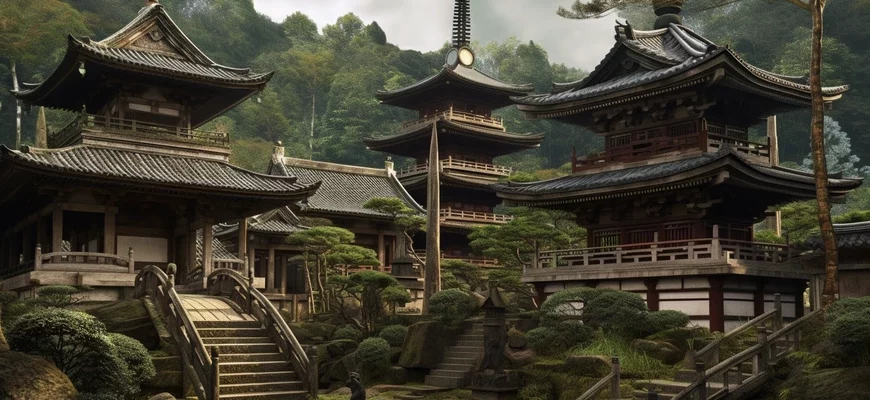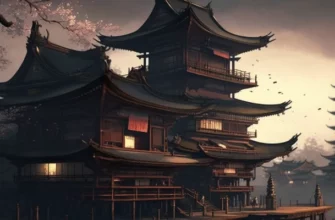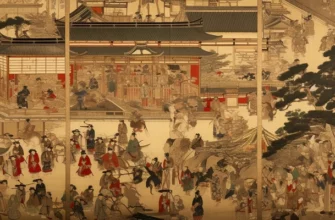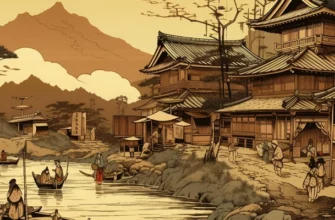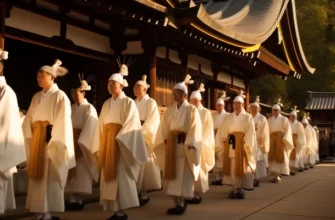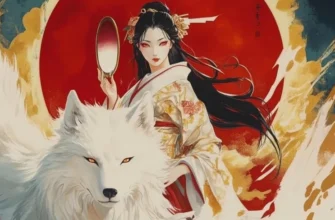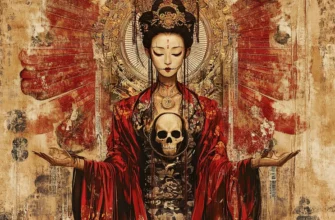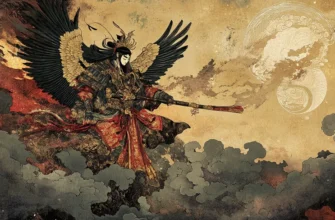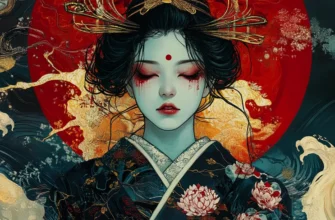Ancient Japan is a period in Japanese history that began around 10,000 BC and lasted until the end of the 7th century AD. This period played an important role in shaping Japan’s national identity.
The first peoples to settle in Japan were hunters and gatherers. Later, they developed agriculture and animal husbandry. In the 3rd-7th centuries AD, the first states, called Kofun and Asuka, began to form. The culture of ancient Japan was strongly influenced by Chinese and Korean cultures.
Ancient Japanese society consisted of nobles and commoners. Great attention was paid to religion. Shinto was considered the national religion, but Buddhism and Confucianism also found their place in Japanese culture.
Ancient Japanese art included sword decoration, lacquerware, ceramics, and other types of art. The architecture of that time was characterized by the traditional Japanese style.
Ancient Japan was a wonderful culture that remains an important part of Japan’s national identity to this day.
- Indigenous peoples and the first states
- Culture of Ancient Japan
- Religion and Art
- Indigenous peoples and the first states
- The creation of the first states: the Kofun and Asuka periods
- Kofun period
- Asuka period
- Culture of Ancient Japan
- Ancient Japanese society
- Writing and calligraphy
- Traditional clothing and cuisine
- The development of architecture: temples, castles, and houses in the traditional Japanese style
- Conclusion
Indigenous peoples and the first states
Ancient Japan was inhabited by primitive peoples who settled in this territory more than 10,000 years ago. These peoples were hunters and gatherers who lived on lands covered with forests and rich in wild animals and plants. Later, they developed agriculture and animal husbandry, which allowed them to secure a stable source of food.
For a long time, several primitive peoples fought for power in Japan. However, until the 3rd-7th centuries AD, when the first states called Kofun and Asuka began to form in Japan, there was no clear state authority.
The Kofun state (250-538 AD) was founded in the territory of the modern prefectures of Nara and Kyoto, and the Asuka state (538-710 AD) – in the territory of Nara Prefecture. During this period, Japan developed and interacted with the cultures of China and Korea. Many elements of Chinese and Korean cultures were reflected in ancient Japanese art and religion.
An important component of Japan’s development was the formation of its social structure. Society at that time consisted of the nobility and the common people. Religion, folk wisdom, and beliefs reflected people’s attitudes toward the world and various beliefs. Shintoism was considered the national religion and still exists today, incorporating ancestor worship and nature worship. Buddhism was introduced to Japan from China and became one of the main religions in the first centuries AD.
In addition, in ancient Japan, it was customary to use the written Chinese language, which became dominant in government affairs and literature. However, over time, a writing system based on Chinese characters and designed to record the ancient Japanese language emerged.
In 710, after the end of the Asuka period, the Nara era began, which marked the emergence of the first capital in Japan – Nara. During this period, Japan explored and realized its connections with other countries and its enormous potential for development.
Later, at the beginning of the 10th century, the Heian era began. Japan was unified and became the first centralized state. During this period, culture and science developed, and there was centralized state power and a taxation system.
Thus, ancient Japan was a period in the country’s history that significantly influenced the development of culture and traditions. The first peoples and states made a great contribution to the history of Japan, laying the foundations for the development of its social, political, and cultural identity.
Culture of Ancient Japan
The culture of ancient Japan has a long history and a rich heritage that has been passed down from generation to generation. It was influenced by Chinese and Korean cultures, but over time it became unique and original.
One of the most famous elements of ancient Japanese culture is the kimono, a traditional garment made of silk and cotton. The kimono has a special meaning for the Japanese, as it is a manifestation of the country’s history and traditions.
Art is another important aspect of ancient Japanese culture. Japanese art is known for its uniqueness and aesthetics, which reflect many aspects of Japanese culture. The most famous types of art in ancient Japan include painting, ceramics, lacquerware, and bonsai, the art of miniature gardening.
Traditions and customs are also important in ancient Japanese culture. For example, the tea ceremony is an important element of Japanese culture that symbolizes hospitality and respect for guests. In addition, music, dance, and theater are also important elements of ancient Japanese culture.
Furthermore, ancient Japanese culture was strongly linked to religion. Shinto, which was considered the national religion, had a major influence on the country’s culture and traditions. Buddhism also played an important role in the development of ancient Japanese culture and art, especially during the Nara and Heian periods.
Ancient Japanese culture is also known for its sporting traditions and martial arts. For example, kendo is a martial art involving swords that developed in Japan and has become popular around the world. Sumo is a traditional Japanese sport that is also popular around the world.
Food culture is another important aspect of ancient Japanese culture. Japanese cuisine is known for its uniqueness and aesthetics. Sushi, rice, miso soup, and various pickled and smoked dishes are just a few examples of traditional Japanese cuisine.
All of these elements of ancient Japanese culture—clothing, art, traditions and customs, religion, sports, and cuisine—played an important role in shaping Japanese identity and spiritual culture.
Religion and Art
Religion and art were important in ancient Japan. Shinto and Buddhism are the two main religions that have influenced Japanese culture and art.
Shinto, which literally means “Way of the Gods,” is the national religion of Japan. It believes that nature and all things have divine power and are endowed with spirits called kami. Shintoism has influenced many aspects of Japanese culture, including art, architecture, music, and literature. Traditional Shinto houses and temples have special symbols that represent kami and reflect Japanese traditions and history.
Buddhism was introduced to Japan from China and Korea in the 6th century. This religion played an important role in the development of ancient Japanese art. Buddhist temples were located in key locations throughout the country, reflecting the influence of Buddhism on Japanese culture. Temples are known for their beautiful buildings, art, and landscape garden design.
Ancient Japanese culture was also associated with various art forms, including painting, calligraphy, ceramics, lacquerware, and bonsai, the art of miniature gardening. These art forms reflect the uniqueness and aesthetics of Japanese culture. For example, calligraphy was an important element of Japanese culture, as the Japanese believe that writing is an expression of a person’s personality. Painting and lacquer art also have their own unique characteristics that reflect Japanese aesthetics.
Japanese ceramics, such as “painted plates” (imari) and “white tea utensils” (ruson), also play an important role in Japanese culture. These types of ceramics are usually handmade and painted in detail, creating a unique style and aesthetic.
Bonsai is the art of miniature gardening that originated in Japan. This art involves growing trees and shrubs in miniature forms, which requires great attention to detail and proportion. Bonsai has become an important element of Japanese culture and has gained popularity around the world.
All of these art forms reflect the uniqueness and aesthetics of ancient Japanese culture. Religion and art were not only important elements of culture, but also reflected the spirituality and deep traditions of Japan.
Indigenous peoples and the first states
The beginning of Japanese history: the first Yayoi period, 300-710
Ancient Japan is a period in Japanese history that lasted from approximately 14,000 BC to the middle of the 8th century AD. During this time, a number of civilizations and cultures emerged that shaped Japan’s development to the present day. The first settlements on the territory of modern Japan appeared about 40,000 years ago, when local inhabitants began to hunt and gather plants.
One of the first cultures in Japan was the Jomon culture, which developed from 14,000 to 300 BC. The name of the culture comes from its characteristic clay pots with bumpy patterns (the Japanese word “jomon” means “spindle”). This culture was known for its sophisticated crafts and ceramics, as well as its advanced martial arts.
During the 3rd-5th centuries AD, the Chinese and Koreans invaded Japan, bringing with them their technologies and culture. This period in Japanese history is called Kofun (300-710) and is marked by the founding of the first state on Japanese territory – Yamato. The Yamato state pursued foreign policy and trade with China and Korea. During this period, there was an intensive adaptation of Chinese culture and technology, which influenced the development of art and architecture.
In 710, Japan became a constitutional monarchy after the proclamation of the Nara Constitution. This period of Japanese history is called the Nara period (710-794). During this period, the Yamato state changed its name to Japan (meaning “land of the morning”) and the capital moved to the city of Nara. A new system of government was established, and Chinese characters and the Chinese calendar were introduced.
In 794, the capital was moved to Kyoto, and this period of Japanese history is called the Heian period (794-1185). During this period, culture, art, and literature flourished. During this period, many samurai clans and military leaders emerged in Japan, competing for power. The Heian period saw the creation of the tea ceremony culture, bunryaku (Japanese novels), and the introduction of the kankyō (national poetry) system.
After the Heian period, the era of feudalism began, which lasted until the end of the 16th century. During this period, many independent states were created in Japan, which competed for power and territory. From 1603, power in the country belonged to the shogunate, a military government that controlled the emperor.
Ancient Japan was a time when the first peoples and states emerged on the territory of modern Japan. The Jomon culture was one of the first cultures in Japan, and the Kofun period was marked by the founding of the first Yamato state.
The creation of the first states: the Kofun and Asuka periods
The Kofun period (250-538) and the Asuka period (538-710) were times in the history of ancient Japan when the first states were formed. During this period, various cultures developed in Japan, including the Jomon and Yayoi cultures, and ethnic groups began to form, which later united to form the first states.
Kofun period
The Kofun period got its name from the kofun burial mounds that were built in Japan during this period. During the Kofun period, the first state in Japan, the Yamato state, was formed. This state gradually expanded its territory and established a strong centralized government.
During the Kofun period, culture developed, particularly the production of ceramics, tools, and jewelry. During this period, a system of recording information on bamboo tablets was also introduced.
Asuka period
During the Asuka period, the Yamato state continued to develop and became an increasingly powerful state. A new administrative system, military system, and legislation were established. The Chinese calendar and Chinese characters were also introduced. During this period, the Yamato state established diplomatic relations with China and Korea.
Many art forms were developed during the Asuka period, including architecture, painting, sculpture, and music. Many buildings were constructed that still remain in Japan today, such as temples and palaces. Famous artworks from the Asuka period include bronze bells and bronze bells, which had religious significance.
During the Asuka period, Buddhism began to spread widely in Japan. Buddhism merged with traditional Japanese religions, such as Shinto, and became an important part of Japanese culture.
In summary, the Kofun and Asuka periods were important stages in the history of ancient Japan, when the first states were formed and culture and art developed. These periods became an important foundation for the further development of Japan and shaped many traditions and customs that are still preserved in Japanese society today.
Culture of Ancient Japan
The culture of Ancient Japan was very diverse and unique, reflecting the influence of traditions and religions that emerged on the islands in ancient times. Japanese culture developed over thousands of years, from the Jomon period to the Edo period.
The Jomon period (14,000 – 300 BC) reflects the early forms of life on the islands, where the first settlements were formed by hunters and gatherers. During this period, ceramics were developed and became an important part of the culture of that time. Also noteworthy are the arts and crafts, in particular the manufacture of jewelry from stone and skiff, as well as fabrics from tree bark.
Later, during the Yayoi period (300 BC – 300 AD), which coincides with the Iron Age, Japanese culture began to resemble modern culture more closely. During this period, new methods of agriculture and iron processing were developed. Also, in the Yayoi period, the first tomb monuments were created – burial mounds, which became a sign of power and wealth. An important part of Japanese culture during this period were masks, which were used during religious ceremonies.
The Kofun period (300-710 CE) was marked by the creation of the first centralized states on the islands. During this period, various forms of art and crafts emerged, such as ceramics, embroidery, and wood carving. An important part of the culture of the Kofun period was the use of bronze bells and chimes in religious ceremonies. Another important part of ancient Japanese culture was architecture. Many buildings of that time, such as temples and palaces, were made of wood, so none of them have survived to this day. However, there are many replicas and reconstructions of ancient buildings that allow researchers to understand what they looked like.
Traditional art in ancient Japan includes many forms, such as calligraphy, painting, sculpture, and theater. Many of these art forms have had a strong influence on Japanese culture as a whole, especially traditional forms of theater such as Noh and Kabuki.
Overall, the culture of ancient Japan was very advanced and unique. Many aspects of it have survived to the present day and influenced the culture of modern Japan.
Ancient Japanese society
Ancient Japanese society can be divided into several periods. The earliest of these is the Jomon period (10,000-300 BC), when people engaged in gathering and hunting, as well as the production of clay pots and jewelry. The next period was Yayoi (300 BC – 300 AD), when the first state formations were formed and agriculture developed.
However, the most famous periods are the Nara (710-794 AD) and Heian (794-1185 AD) periods, when Japan experienced significant cultural and social development. At this time, an imperial system of government was formed, with the emperor occupying the highest position in the state. The country was divided into provinces, which were ruled by governors.
During the Heian period, a significant cultural revolution took place, caused by the influence of Chinese culture. At this time, two main writing systems were developed: hiragana and katakana. Buddhism also developed significantly and became an important religion in the country.
Society was divided into castes, which consisted of the emperor, nobility, samurai, merchants, and commoners. During the Heian period, emperors lost most of their powers, and the nobility became the main rulers of the country. However, over time, the samurai began to gain great power, which led to changes in the political system.
In general, ancient Japan was a society with a complex structure and culture that was influenced by many factors. Since then, Japan, its culture, and society have changed quite a bit. The next important period is the samurai period, which lasted from the 12th to the 19th century. Samurai were warrior aristocrats who were mostly servants of the state and its rulers. During this period, a system of martial arts was developed, including kendo, which is still an important aspect of Japanese culture.
In the 19th century, Japan opened up to the West and underwent significant changes in politics, economics, and culture. Since then, many Western innovations and technologies have been adopted, helping Japan become one of the most developed countries in the world. Modern Japanese society can be described as a highly developed technological state with a complex culture and social structure.
In modern Japan, an important aspect of culture is manga and anime, which are an important component of pop culture in the country and are gaining popularity around the world. Japan is also known for its traditional arts, such as kabuki, musical instrument theater, ceramics, lacquerware, and more. Japanese cuisine is also famous around the world, with dishes such as sushi, ramen, and udon.
Writing and calligraphy
Writing and calligraphy were important aspects of ancient Japanese culture. Before the arrival of the Chinese in the 6th century, the Japanese did not have their own writing system, but they quickly adopted Chinese writing along with Chinese culture, which greatly influenced their culture and art.
In the middle of the 8th century, the Japanese invented their own writing system, kana, which consisted of two components: hiragana and katakana. Hiragana and katakana are two ways of writing the same sounds, but they have different structures and are used in different situations.
Calligraphy was an important art in ancient Japan and is still an important aspect of Japanese culture today. In Japanese calligraphy, greater emphasis is placed on expressiveness and emotionality than on the correctness of writing characters. Calligraphy was associated with knowledge of Chinese writing, as well as many other art forms, such as painting, poetry, and martial arts.
In Japanese culture, calligraphy is used as a way to express ideas and feelings, as well as to create original works of art. Calligraphy is also an important part of many religious and ceremonial rituals in Japan, such as tea ceremonies and memorial ceremonies.
Traditional clothing and cuisine
The traditional clothing and cuisine of ancient Japan also played an important role in the culture of the era.
Traditional Japanese clothing is called a kimono. It was common among the Japanese for many centuries and was used as both everyday and festive clothing. The kimono had a simple but elegant design, was made of silk, cotton, or linen, and was decorated with a variety of beautiful patterns.
Other traditional clothing items include geta, wooden shoes with straps that were used to protect the kimono from dirt and dust, as well as fans and umbrellas.
Traditional Japanese cuisine also has a rich history and cultural heritage. One of the most famous dishes is sushi, which originated in ancient Japan. It consists of rice, usually seasoned with vinegar and sugar, to which seafood is added, which is first marinated in soy sauce and other spices.
Other popular dishes include ramen, which consists of meat broth, various types of meat and vegetables; udon, a soup with meat or fish; and tempura, which consists of fried vegetables or seafood dipped in light batter and deep-fried.
Another important aspect of Japanese cuisine is the tea ceremony, which involves the preparation and serving of tea using special vessels and ritual gestures. This ceremony is an important symbol of Japanese culture and aesthetics.
Another popular drink is sake, a rice wine that also has a long history and symbolism. Sake is considered a festive drink and is used in various celebrations and ceremonies.
In addition to traditional foods and drinks, the tradition of dining with family and friends is also important in Japanese culture. This is called ikuya, which means “family life.” During this time, people gather around the table and enjoy food and conversation.
Overall, the traditional clothing and cuisine of ancient Japan reflect important aspects of the culture and lifestyle of the people of that time. They are still important to the Japanese and have become recognized around the world as unique symbols of Japanese culture and style.
The development of architecture: temples, castles, and houses in the traditional Japanese style
The architecture of ancient Japan developed over a long period of time and included many different styles and forms. One of the most famous elements of Japanese architecture is temples, castles, and houses, which reflect Japan’s rich cultural heritage.
Temples are spiritual places that play an important role in Japanese culture. They have their own unique features in terms of construction and design. Most temples were built of wood and stone and had a traditional Japanese architectural form consisting of wooden gables and stone foundations.
Particular attention was paid to details and decorations, which were made by hand and included elements from various materials such as wood, bamboo, stone, and others. Castles were another important element of Japanese architecture, used as defensive structures and places of residence.
Castles came in various shapes and styles, including wooden and stone structures. One of the most famous castles in Japan is Hiroshima Castle, which was built in the 17th century and has a traditional Japanese architectural form.
Houses in the traditional Japanese style had distinctive features in their design and functionality. Traditional houses were usually built of wood and had a simple shape with thin walls and striped roofs. They also had traditional features in the layout of the interior space. One of the main principles was related to the use of tatami mats, which were special mats that could be used for sitting, sleeping, and performing various ceremonies. In addition, partitions and folding door and window systems were used inside the houses, allowing the configuration of the space to be changed according to needs.
The traditional Japanese building style also used various decorative elements that complemented the architectural forms and decorated the interiors. For example, elements such as screens, lanterns, lamps, ceramic figurines, and others.
An important feature of Japanese architecture was its ephemeral nature. Buildings and structures usually had a short lifespan and needed to be frequently restored and rebuilt. This was because Japanese builders mainly used wood, which wears out quickly and is susceptible to natural factors.
Overall, the architecture of ancient Japan has its own unique features and characteristics that make it unique and valuable to Japan’s cultural heritage.
Conclusion
Ancient Japan is a fascinating era that shaped the rich history and culture of this country. From the time the first humans appeared on the territory of modern Japan to the arrival of the first European missionaries and traders, it was a period of innovation and development.
Ancient Japanese society was very hierarchical and structured, with different social groups performing their roles and duties. Japanese writing and calligraphy had their own unique style and were an integral part of the culture of the time. The traditional clothing and cuisine of ancient Japan were also unique and have had an influence on modern Japanese culture.
The architecture of ancient Japan had its own unique features, such as the use of wood, ephemerality, and minimalism. Houses and temples were elegant and built with respect for nature and spiritual values.
Ancient Japan remains one of the most intriguing periods in the country’s history, and its culture and innovations have had a profound influence on modern Japanese culture and society. Ancient Japan was a remarkable culture that continues to inspire admiration and interest to this day. Its history and culture remain an important part of Japan’s national identity.
